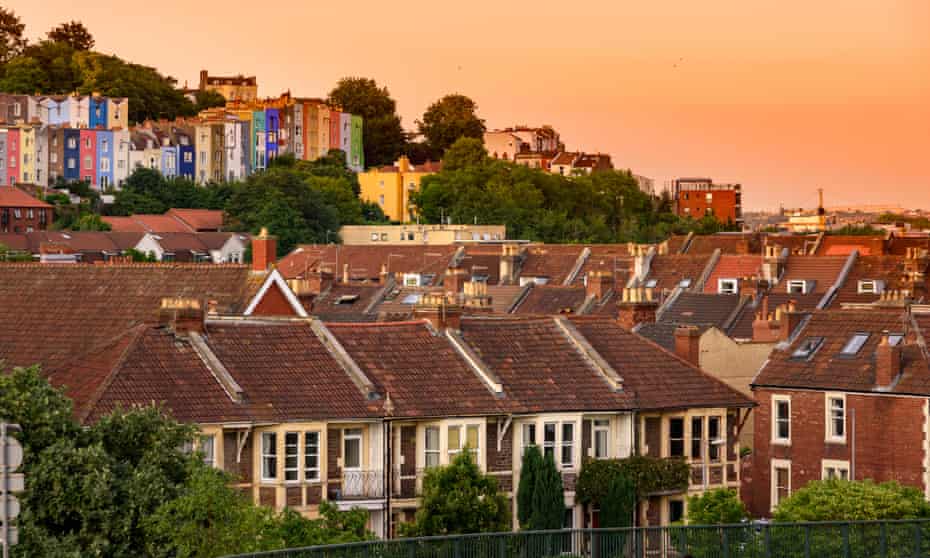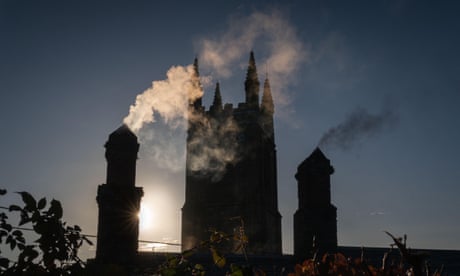GENTRIFICATION KILLS
Do wood burners add to air pollution in cities? Yes, say citizen scientistsPioneering Bristol study blames the solid-fuel burners in people’s homes for breaches of World Health Organisation guidelines

Rapidly gentrifying Bristol, where many residents have installed wood burners.
Photograph: Shahid Khan/Alamy
Tom Wall
Sun 29 May 2022
Like many parts of the country, Bristol has experienced a huge rise in the number of houses installing wood burners over the past decade. But as they have proliferated, mainly in the wealthier parts of the city where many Victorian and Georgian houses have been renovated, so too have fears that they cause pollution.
And now a group of citizen scientists taking part in the first community-led project targeting toxic smoke from wood burners has discovered new evidence about their dangers.
Ten volunteers based in a rapidly gentrifying Bristol inner-city neighbourhood with one of the highest concentrations of solid fuel-burning appliances in the city, recorded 11 breaches of World Health Organization daily guidelines for ultra-fine particulate pollution over a period of six months.
Tom Wall
Sun 29 May 2022
Like many parts of the country, Bristol has experienced a huge rise in the number of houses installing wood burners over the past decade. But as they have proliferated, mainly in the wealthier parts of the city where many Victorian and Georgian houses have been renovated, so too have fears that they cause pollution.
And now a group of citizen scientists taking part in the first community-led project targeting toxic smoke from wood burners has discovered new evidence about their dangers.
Ten volunteers based in a rapidly gentrifying Bristol inner-city neighbourhood with one of the highest concentrations of solid fuel-burning appliances in the city, recorded 11 breaches of World Health Organization daily guidelines for ultra-fine particulate pollution over a period of six months.
The project is thought to be the first where volunteers have been given newly affordable monitoring technology to gauge pollution partly caused by domestic combustion.
Sensors were placed throughout Ashley ward, which encompasses deprived parts of St Pauls and better-off Bristol neighbourhoods such as Montpelier. Oluwatosin Shittu, 40, who lives in St Pauls, found his sensor picked up more pollution during the weekend when some residents were burning wood and during rush hours when cars queued on local roads.
“At the weekend [pollution] was high because obviously up the hill [in Montpelier] people were burning wood,” he said.
Steve Crawshaw, who manages the project for the council, said domestic wood burning was a serious and growing problem. He added that the number of days exceeding WHO pollution guidelines in the ward were broadly in line with the city average, but still a cause of concern.
Wood burning and traffic produces tiny airborne particles – so called PM 2.5, or fine particulate matter of 2.5 micrometres or less in diameter – that can pass through the lungs and into the bloodstream, causing cardiovascular problems, respiratory disease, and cancers.
“The evidence is that virtually any level of PM 2.5 is harmful – there is no threshold below which you don’t see health effects,” Crawshaw said. “There are around 300 deaths a year in Bristol due to poor air quality and at least half of those deaths – 150 – are down to PM 2.5.”
The number of solid fuel appliances such as log burners installed in Bristol increased sevenfold in the decade after 2007, with just over 900 installations recorded in 2017.
“We’ve forgotten the journey we’ve been on with clean air. In the 1950s at least 4,000 people died in the smog in London in five days,” said Crawshaw. “That led to the clean air act, then natural gas started to get piped into homes in the 1960s. Most people stopped burning wood because it was dirty and inconvenient. Now it’s become a fashionable lifestyle choice.”
The council hopes the project will raise awareness of the health impact of wood smoke and encourage residents to turn on their central heating instead of loading up their log burners in the colder months. Crawshaw added: “We want citizen scientists to become community ambassadors for improving air quality and help change behaviour in the city.”
From the start of this year all new wood burners sold must be so-called “ecodesign”, but Crawshaw said: “Even if people burn clean, dry wood, those stoves are still grossly polluting compared with gas and electric.”
The smoke in the ward is not just coming from middle-class homes. There is a van-dwelling community in the area, with some burning wood to stay warm. Soaring energy costs are also driving some struggling families to use open fires again.

Avoid using wood burning stoves if possible, warn health experts
“Increasingly people are keeping warm by having an open fire in one room and turning off the central heating,” he said. “We recognise some people living in poverty don’t have an alternative. We’re not saying ‘you must freeze’ – we are taking a socially just approach.”
The latest analysis from the Department for Environment, Food and Rural Affairs (Defra) reveals that wood burners and open fires are now responsible for 17% of the country’s total PM 2.5 pollution – more than the pollution caused by road traffic. Nationally, emissions from domestic wood burning increased by 35% between 2010 and 2020.

Wood burners emit more particle pollution than traffic, UK data shows
The government is consulting on introducing a new target for small particulates of 10 micrograms per cubic metre for England by 2040. However, this is close to existing levels in cities such as Bristol and double safe concentrations set by the WHO.
A Defra spokesperson said PM 2.5 pollution had fallen by 18% since 2010 but more needed to be done: “We have legislated the phasing-out of the sale of the most polluting solid fuels in domestic combustion, and have committed to driving down emissions across all modes of transport.”
No comments:
Post a Comment